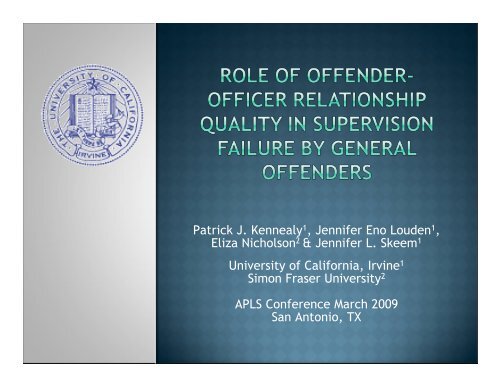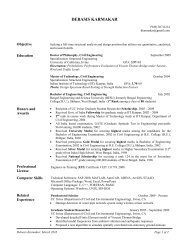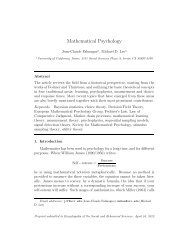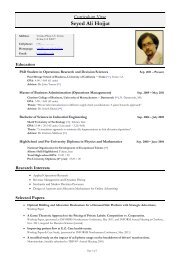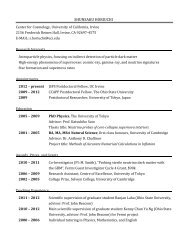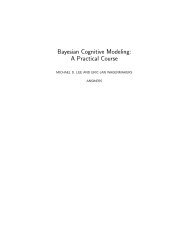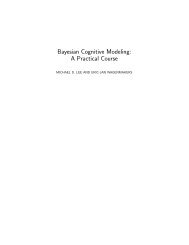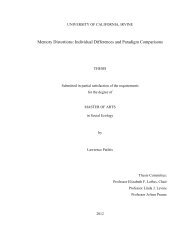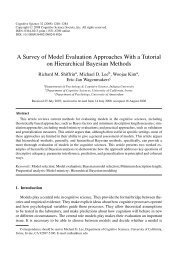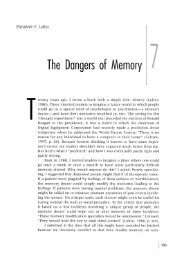APLS 2009 Presentation_final - UCI Webfiles
APLS 2009 Presentation_final - UCI Webfiles
APLS 2009 Presentation_final - UCI Webfiles
You also want an ePaper? Increase the reach of your titles
YUMPU automatically turns print PDFs into web optimized ePapers that Google loves.
Patrick J. Kennealy 1 , Jennifer Eno Louden 1 ,<br />
Eliza Nicholson 2 & Jennifer L. Skeem 1<br />
University of California, Irvine 1<br />
Simon Fraser University 2<br />
<strong>APLS</strong> Conference March <strong>2009</strong><br />
San Antonio, TX
RQ described as “quintessential integrative<br />
variable” across treatments and influences:<br />
Patient satisfaction<br />
Treatment adherence<br />
Therapeutic outcomes<br />
Wolf & Goldfried, 1988, p. 449<br />
Typically evaluated by measures of<br />
Therapeutic Alliance (TA)<br />
Affective bond<br />
Collaboration
Development of RQ in criminal justice<br />
settings are complicated by:<br />
Client/Provider characteristics<br />
System factors<br />
Ross, Polaschek, & Ward (2008)<br />
Setting differences require providers to<br />
perform dual-roles (D-R)<br />
Counselor<br />
Control<br />
Trotter, 1999
Development of Dual-Role Relationships<br />
Inventory-Revised (DRI-R)<br />
30-item questionnaire<br />
Renders total score and 3 factors<br />
Caring-Fairness<br />
Trust<br />
Toughness<br />
Skeem, Eno Louden, Polaschek, & Camp, 2007
Skeem & colleagues (2007) report that in<br />
offenders with mental illness…<br />
D-R RQ was predictive of:<br />
Observer-rated within session behavior<br />
Confrontation by officer<br />
Change talk & resistance by offender<br />
Rule compliance<br />
TA was not predictive of:<br />
Observer-rated within session behavior<br />
Rule compliance
Little is known about the mechanisms underlying<br />
the association between D-R RQ and supervision<br />
failure<br />
Skeem & Colleagues (2007) suggest:<br />
Perceived fairness of decisions<br />
Effective use of counseling and control roles<br />
Alternative explanations include potential<br />
confounds of:<br />
Risk-Level & Personality<br />
Dual-Role<br />
RQ<br />
Risk<br />
Supervision<br />
Failure
Does D-R RQ predict future supervision<br />
failure among general offenders?<br />
Are parolee ratings of D-R RQ a function of<br />
their risk level or personality?<br />
Is D-R RQ predictive of supervision failure<br />
beyond risk and personality?
Participants<br />
Sample of General Offenders on Parole<br />
N = 109<br />
Baseline Assessment<br />
DRI-R<br />
Level of Service/Case Management Inventory (LS/CMI)<br />
Andrews, Bonta, & Wormith, 2004<br />
History Clinical Risk 20 (HCR-20)<br />
Webster, Douglas, Eaves & Hart, 1997<br />
Multidimensional Personality Questionnaire-Brief From (MPQ-BF)<br />
Patrick, Curtin, & Tellegen, 2002<br />
Criminal Justice Outcomes<br />
Arrests and Returns to Custody<br />
Measured via official state parole records<br />
Average follow-up period was about 18 months
Does D-R RQ predict future supervision<br />
failure among general offenders?
Arrests RTC<br />
DRI-R Total -.29** -.17<br />
* p < .05; ** p < .01.
Are parolee ratings of D-R RQ a function of<br />
their risk level or personality?
Risk Measures<br />
DRI-R<br />
Total<br />
DRI-R<br />
Caring-<br />
Fairness<br />
DRI-R<br />
Trust<br />
DRI-R<br />
Toughness<br />
LS/CMI Total Score -.14 -.13 -.19 * .17<br />
HCR-20 Total Score -.13 -.09 -.24* .13<br />
Personality Measures<br />
Positive Emotionality -.09 -.10 -.05 .04<br />
Negative Emotionality -.07 -.02 -.23* .12<br />
Constraint .04 .02 .11 -.02<br />
* p < .05; ** p < .01.
Is D-R RQ predictive of supervision failure<br />
beyond risk and personality?
Risk<br />
Arrests RTC<br />
LS/CMI Total .29** .15<br />
HCR-20 Total .20† -.07<br />
Personality<br />
Positive Emotionality .04 -.01<br />
Negative Emotionality .19* .16<br />
Constraint -.06 -.11<br />
† p < .08; * p < .05; ** p < .01.
Hazard ratios for DRI-R & LS/CMI predicting<br />
number of days until first:<br />
DRI-R<br />
Arrests Scoring<br />
Range<br />
LS/CMI Total Score 1.05** 0-43<br />
DRI-R Total Scores .76* 1-7<br />
* p < .05; ** p < .01.
Key Findings<br />
D-R relationships characterized by firm, but fair<br />
approach influence whether offenders succeed<br />
Predictive utility of D-R RQ for supervision failure is not<br />
a function of risk level and personality<br />
Future Directions<br />
Examine how D-R RQ may change over time<br />
Examine utility of Officer-rated D-R RQ in general<br />
offenders
California Policy Research Center<br />
<strong>UCI</strong> South Central Research Team<br />
Region III, South Central Parole Office


